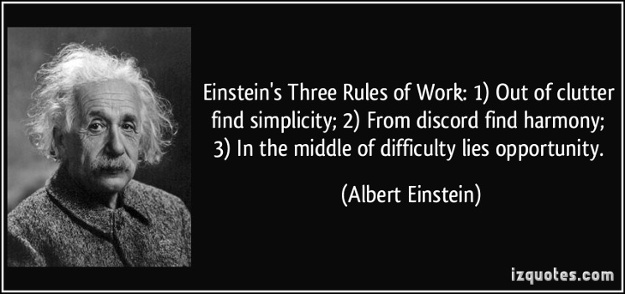
In last week’s blog we talked about getting “behind the boxes” of the organizational structure to look at the fabric of the organization, the community of people behind the roles, and the connections among them. Today’s blog is about reducing complexity in organizational design, while simultaneously improving performance and employee engagement.
You’re likely familiar with TEDtalks. With over 1,600 talks, viewed over a billion times, TED (technology, entertainment, design) has lived up to its tag line of “ideas worth spreading”. You’ve likely listened to a number of them.
Today’s blog originated with one of these talks, presented by Boston Consulting Group‘s Yves Morieux entitled As Work Gets More Complex 6 Rules To Simplify. Morieux’s TEDtalk is both informative and entertaining…and it comes with subtitles. Posted in January, 2014, and with over 1 million views and growing, it obviously is resonating. We hope you’ll think it is worth a view when you have 20 minutes to spare.
One recent viewer comments:
“in my organization we’re full of managers and directors who (1) make no decisions (2) take no risks (3) make no changes (4) form committees (5) hire consultants, then repeat steps one to five until the problem goes away. The incompetent worker, manager or director retains a clean record with no bad decisions, no blemishes, no anything = promotion! And we wonder why the workforce is slowly becoming disengaged.”
Yves Morieux is a senior partner and managing director. Working in BCG’s global people and organization practise group his research area focuses on new business organizational design and strategy, viewed through the prism of productivity and engagement trends and their drivers. His studies incorporate social sciences research into such areas as organizational sociology and behavioral economics enriched by in-the-field experience at hundreds of organizations across multiple industries. You can see his bio here.
His central area of study is premised on the notion that the global economy is going through a new transformational stage, and every economic transformation necessarily entails an organizational one as well. Organizational forms that fail to adapt are eliminated by the market.
His thesis may sound deterministic, but it is based on the observation that certain organizations are succeeding, and that their success has implications for the way work is performed, organized, and managed. It is also grounded in experience – his, as well as ours. We all sense that some organizations – perhaps ours, perhaps not – are succeeding better than others in an environment of increasing competition and dynamic change.
Morieux observes that the “twin pillars” of the “hard” (structure, process, methods, metrics, KPIs) and “soft” (feelings, interpersonal relationships, traits) tools used to support organizational strategy, productivity growth and employee engagement are “obsolete” in an environment of increasing complexity. Changes in the “hard” of organizational structure yield only higher levels of complexity, without “moving the dial” on business performance. Changes in the “soft” of people dynamics in the workplace have not cracked the code on employee engagement (quite the contrary, in fact), and seem to be predicated on the faulty notion that the more we know and like each other the more we are likely to co-operate. Not so, apparently.
He describes, instead, and advocates for a strategy of “smart simplicity” — creating an environment in which employees can work with one another co-operatively and adaptively to develop creative solutions to complex challenges. This approach leads to simultaneous increases in employee performance and satisfaction that are larger than those that result from alternative approaches such as business re-engineering or restructuring efforts on the one hand and “people initiatives” on the other. Sounds enticing!

“Smart simplicity” is a framework for business process re-engineering encompassing six “smart rules” that can help managers enhance output without adding to organizational complexity or cost.
The first three involve enabling—providing the information needed to understand where the problems are and empowering the right people to make good choices.
The second three involve impelling—motivating people to apply all their abilities and to cooperate, thanks to feedback loops that expose them as directly as possible to the consequences of their actions.
By implementing these types of fluid rule-making structures organizations tip the balance in favor of empowering their personnel to find solutions to complex performance requirements rather than disengaging, ducking cooperation, or finger-pointing.
Its basic tenets are as follows:
- Understanding what others do. Go beyond the surface of the container, the job description, the role to truly understand the content of the roles of people in the organization.
- Reinforcing the integrators so their power and interests in co-operation are magnified. Remove the structural barriers and layers that prevent your integrators (managers) from collaborating. Remove the rules with growth, don’t add to them.
- Increasing the quantity of power in your organizational environment. Give more power to more people to make more decisions autonomously, using their intelligence and judgment.
- Increasing the shadow of the future. Let people see and truly understand the consequences of their actions and decisions through better feedback loops.
- Increasing reciprocity. Remove the buffers (barriers) between people that artificially promote notions of self-sufficiency but instead yield inefficiency and dysfunction. “Get rid of the second TV”. (You’ll need to watch the video to get that one!!)
- Rewarding the co-operators. Instill a culture where failure is not about keeping track of the errors people make, but instead is about failing to provide help when you are asked, and failing to ask for help when you need it.
Some related resources elaborating on these rules include the Harvard Business Review article “Smart Rules: 6 Ways To Get People To Solve Problems Without You” .
If you want some perspective on the evolution of these ideas, in an earlier study on People Engagement (2010) Yves Morieux describes the importance of “adaptive advantage” achieved “through a process comprising variation, selection, and amplification, with modulation at its center”. His summary of the key elements is extracted below:
- Modular organizational units provide flexibility in a changing environment. Standardized (plug-and-play) interfaces enable the organization to recombine parts and rapidly introduce variations in products and processes at low cost and risk, as well as rapid shifts in resource allocation.
- The free flow of knowledge and power enabled by decentralized decision-making allows operations to detect and respond quickly to changes. This attribute is often reinforced by weak or competing power structures and a culture of constructive conflict and dissenting opinions.
- A limited number of guiding principles replace detailed standard operating procedures, which are impractical for managing unpredictable change. Adaptive organizations favor simple universal principles over strict rules for determining how individuals and teams should interact and how decisions should be made.
- Adaptive values encourage the organization to pursue economics favorable to experimentation rather than focus on avoiding failure, which is seen as a necessary part of experimentation. Adaptive values also promote productive dissidence, cognitive diversity, and an external orientation in order to allow a faster and more accurate response to a changing environment. And because adaptive organizations rely on individual creativity and initiative, they articulate a credible common purpose that transcends financial goals and mobilizes employees.
- Leadership through context setting acknowledges that in adaptive organizations, strategies are emergent rather than dictated. Therefore, leadership’s role is to shape the context for decision making rather than to specify and oversee the execution of an instruction set. The emphasis shifts from command and control to contextualize and catalyze.
These ideas, and those in some of our earlier blogs, speak to the notion of getting beyond the “lines and boxes” of organizational design to connecting the people in your organizational into a more dynamic, adaptive and emotionally connected workplace community…regardless of where and how they work, and the tools and methods they use to connect into and contribute to your workplace and the work you produce.

If you’re interested in learning more about how we are re-imagining org charts to reflect these kinds of approaches to organizational design we hope you will check us out.
Thanks to Joe Gelata for finding Yves Morieux for us.
The Organimi Team
